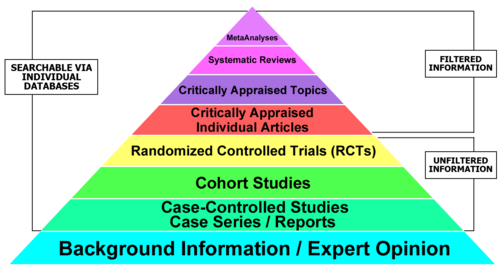
Evidence-based Practice (EBP)
EBP is a process used to review, analyze, and translate the latest scientific evidence. The goal is to incorporate research, with clinical experience and patient preference, into clinical practice, so nurses can make informed patient-care decisions (Dang et al., 2022).
(PICO)
Population, Intervention, Comparison, and Outcome - framework used by researchers to formulate a research question and literature review.
Population/ Patient/Problem (P) Age, sex, Ethnicity, Socioeconomic factors & problem /condition
Intervention (I) – What is the action (intervention, treatment) - Order a test/ procedure , Prescribe a drug
Comparison (C) – To what other action? A different drug/ test/procedure- No medication or placebo
Outcome (O) – What do we anticipate as an outcome? achieve, measure, or change - symptoms, test results, Reduce adverse events, Improve function, OR the result NOT desired.

Evidence-based practice uses the PICO model for formulating a searchable question.
PICO is a mnemonic used to describe the four elements of a good clinical foreground question:
P = Population/Problem
How would I describe the problem or a group of patients similar to mine?
I = Intervention
What main intervention, prognostic factor or exposure am I considering?
C = Comparison
Is there an alternative to compare with the intervention?
O = Outcome
What do I hope to accomplish, measure, improve or affect?
Evidence-based nursing is a part of the larger scope of evidence-based practice. One of the most common definitions of evidence-based practice comes from Dr. David Sackett. He describes EBP as:
"...the conscientious, explicit and judicious use of current best evidence in making decisions about the care of the individual patient. It means integrating individual clinical expertise with the best available external clinical evidence from systematic research."
Sackett, D. Evidence-based Medicine - What it is and what it isn't. BMJ 1996; 312:71-72.
The following diagram can help illustrate the components that go into evidence-based practice:




Formulating a Clinical Question - an interactive tutorial from Boston University
Forming Focused Questions - PICO guide from the Centre for Evidence-Based Medicine (CEBM)
PICO Worksheet & Search Strategy- downloadable Word document provided by the University of Southern California
How to Form an Answerable Clinical Question - Cincinnati Children's walks you through an overview of the PICO method
Seven Steps to the Perfect Pico - a step-by-step guide to formulating an optimal PICO search
